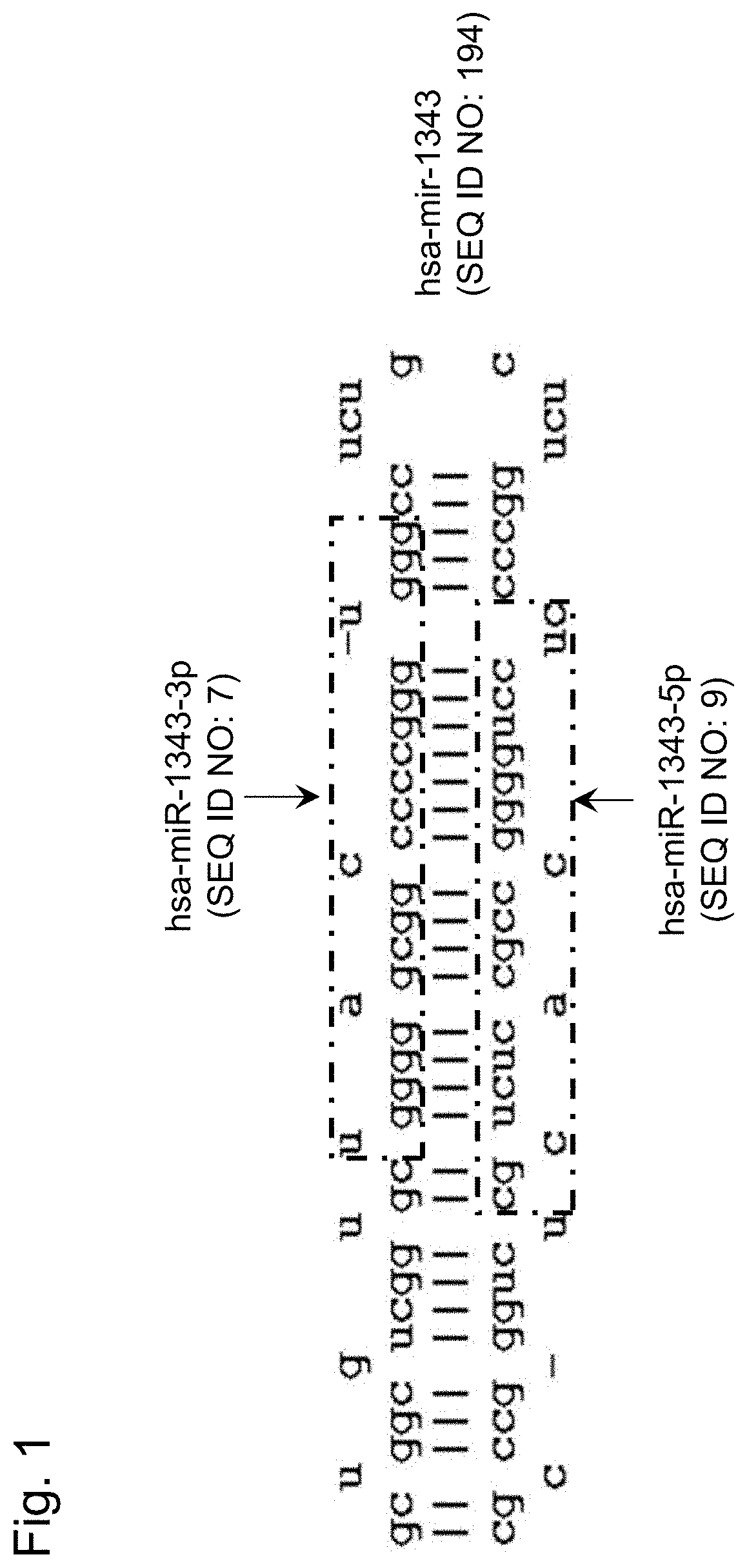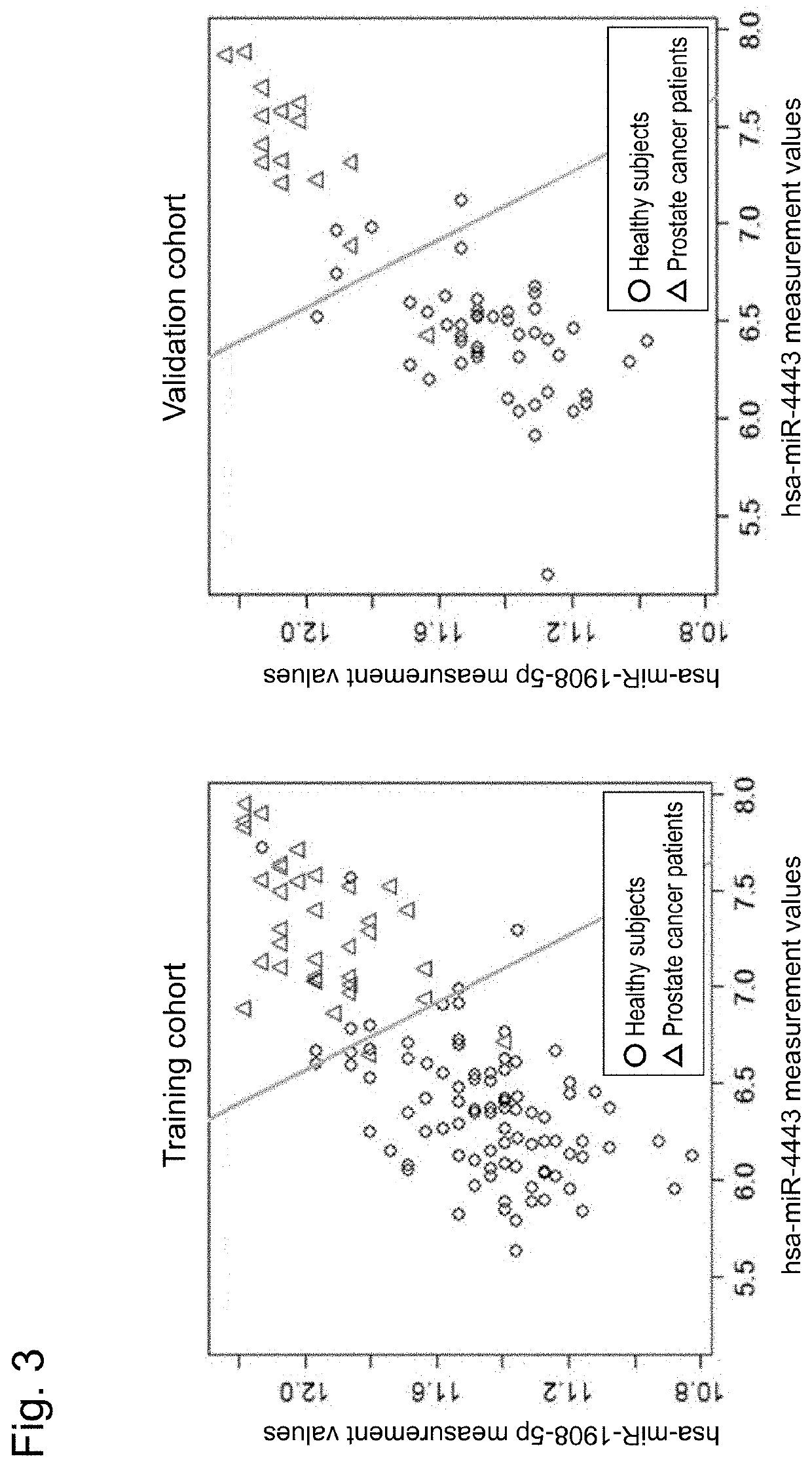Prostate cancer detection kit or device, and detection method
a prostate cancer and kit technology, applied in the field of prostate cancer detection kits or devices, can solve the problems of relatively fast progress, achieve the effects of reducing the burden on patients, high sensitivity, and reducing the rate of recurren
- Summary
- Abstract
- Description
- Claims
- Application Information
AI Technical Summary
Benefits of technology
Problems solved by technology
Method used
Image
Examples
reference example 1
[0804]
[0805]Serum was collected after obtainment of informed consent, using VENOJECT II vacuum blood collecting tube VP-AS109K60 (Terumo Corp.) from each of 94 healthy male subjects, and 35 prostate cancer patients (30 cases with stage II, 1 case with stage III, and 4 cases with stage IV) (Table 2-1) who were confirmed to have no cancer in organs other than the prostate, and used as a training cohort. Likewise, serum was collected after obtainment of informed consent, using VENOJECT II vacuum blood collecting tube VP-AS109K60 (Terumo Corp.) from each of 47 healthy male subjects, and 17 prostate cancer patients (15 cases with stage II and 2 cases with stage III) (Table 2-2) who were confirmed to have no cancer in organs other than the prostate, and used as a validation cohort.
[0806]
[0807]Total RNA was obtained from 3004 of the serum sample obtained from each of 193 persons in total of 141 healthy male subjects and 52 prostate cancer patients in the training cohort and the validation ...
reference example 2
[0810]
[0811]Serum was collected using VENOJECT II vacuum blood collecting tube VP-AS109K60 (Terumo Corp.) from each of 63 breast cancer patients who were confirmed to have no cancer in other organs after obtainment of informed consent, and used as a training cohort together with the samples of 35 prostate cancer patients and 99 healthy male subjects of Reference Example 1. Likewise, serum was collected using VENOJECT II vacuum blood collecting tube VP-AS109K60 (Terumo Corp.) from each of 30 breast cancer patients who were confirmed to have no cancer in other organs after obtainment of informed consent, and used as a validation cohort together with the samples of 17 prostate cancer patients who were confirmed to have no cancer in organs other than the prostate and 51 healthy male subjects of Reference Example 1. Subsequent operations were conducted in the same way as in Reference Example 1.
example 1
[0812]
[0813]In this Example, a gene marker for discriminating a prostate cancer patient from a healthy subject was selected from the training cohort and studied in samples of the validation cohort independent of the training cohort.
[0814]Specifically, first, the miRNA expression levels of the training cohort and the validation cohort obtained in the preceding Reference Examples 1 were combined and normalized by quantile normalization.
[0815]Next, genes for diagnosis were selected in the training cohort. Here, in order to acquire diagnostic markers with higher reliability, only genes that showed gene expression levels of 26 or higher in 50% or more of the samples in either of the prostate cancer patient group in the training cohort or the healthy subject group in the training cohort were selected. In order to further acquire statistically significant genes for discriminating a prostate cancer patient group from a healthy subject group, the P value obtained by two-tailed t-test assumin...
PUM
| Property | Measurement | Unit |
|---|---|---|
| Fraction | aaaaa | aaaaa |
| Fraction | aaaaa | aaaaa |
| Fraction | aaaaa | aaaaa |
Abstract
Description
Claims
Application Information
 Login to View More
Login to View More - R&D
- Intellectual Property
- Life Sciences
- Materials
- Tech Scout
- Unparalleled Data Quality
- Higher Quality Content
- 60% Fewer Hallucinations
Browse by: Latest US Patents, China's latest patents, Technical Efficacy Thesaurus, Application Domain, Technology Topic, Popular Technical Reports.
© 2025 PatSnap. All rights reserved.Legal|Privacy policy|Modern Slavery Act Transparency Statement|Sitemap|About US| Contact US: help@patsnap.com



